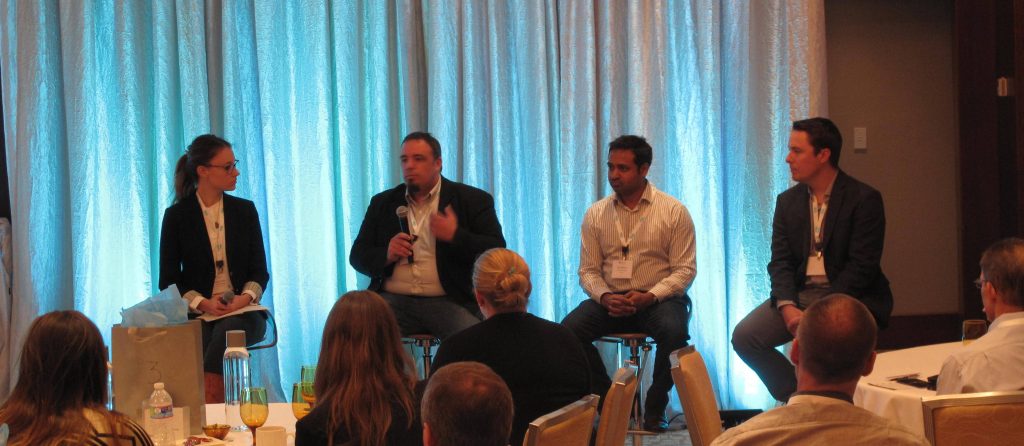
It was my privilege to host the Bleeding Edge: Mobile Strategies for Retail Marketing discussion panel at this year’s #AlignedCon. Our three panelists, Jeff Peden CEO of CraveLabs, Raj Aggarwal CEO of Localytics, and Matt Talbot CEO of GoSpotCheck, are all notable players in the cutting edge of digital marketing. Here are some of their key insights on mobile strategies:
Anna: Raj, what does it mean when you say that we are living in an app-centric landscape?
Raj: People have realized, and there’s very little real argument about it anymore, that apps provide a stronger end-user experience. When you look at usage on mobile, 80% of it is in apps today. That is pretty incredible, but it doesn’t mean that that other 20% isn’t significant and it doesn’t mean that every brand should have an app. For a mobile user who is only going to a company’s website once in a while, who is not going to create an ongoing relationship with a brand, maybe a mobile-optimized website is more suitable than an app.
Anna: Jeff, you’ve told me that mobiles are an important way to start conversations with consumers. Can you explain that more?
Jeff: To play off Raj’s comment, when you look at the average consumer, he or she has maybe 20 or 25 apps on a phone at any given time. We’re in the middle of a study with the media lab at MIT. We’re looking at people who fall asleep at night listening to a radio app, then wake up with their alarm clock app. Then they go in and check the weather, and then use an app to check on their bus. Later in the day, they use an app to do a workout routine. All of these points through the consumer’s day offer moments when we can reach an audience of one in a very personalized way, if we’re delivering the right message. So when we work with our brands, we’re trying to focus not on messages like, “let’s shop here now” but to tell a story, to lift that person’s day just a little bit.
I look around this room and see that everybody here has a mobile device. So I know that you know how intimate the relationship with these devices is. A mobile is a very modern device, but it is also like legacy media. This device looks more like traditional media, like print or TV or radio. This device is all of those at once. So when we look at leveraging it, especially in the local space, we look at how do we take this device that is inherently personal, inherently has the space of one, and we ask how we can leverage it the same way that we leverage other marketing tools.
Anna: Jeff, how do marketers actually engage with that kind of marketing?
Jeff: Looking at campaigns, we’ve asked, how did the brand experience change, based on the buyers’ demographics? We’ve seen campaigns that have launched with multiple versions of creative, and we’ve been able to give feedback in real time. We’ve seen instances in real time where an ad that features a hip-hop artist is playing better on the West Coast than it is on the East Coast, where an ad that features a basketball star is actually playing much better. These are things that only work well for the brand when it understands local, understands the retailer mix, and understands that audiences are different across their entire brand matrix.
Anna: Matt, can you talk about some of the mobile technologies that are helping to get retailers engaged in the store?
Matt: Certainly mobile has become really ingrained in every consumer’s life. We know that there is a lot of money going into building amazing in-store experiences, right? Displays, things that make the shopping experience a lot more immersive in stores. And of course we are already focusing on strategies that bring customers into stores. But we are trying to focus on that last mile, making sure that your brand promise is being executed in the store.
We are capturing data that can help brands understand what’s happening in stores, so they can make better decisions. If you are investing in a display, what percentage of the time is it getting set up in stores? Where is it in those stores? Is it in the back corner, or is it right in the front?
Getting all this data wasn’t possible until the saturation of mobile. In earlier times, people could capture some of it using clipboards and digital cameras – “here’s a picture of your display.” But today we can develop a true data set about in-store performance. And I think that is a trend that we will see over the next few years. We will see more and more productivity tools for employees, seeing them have the same expectations for the apps that help them do their jobs as they have for the apps that they use for entertainment and information.
Jeff Peden is CEO and Founder of CraveLabs, a Boston-based mobile advertising technology firm that specializes in leveling the playing field for small businesses. Previously, Jeff was a co-founder of and CTO for Newbury Networks, a Boston based company that focused on indoor location tracking systems for enterprise wireless networks.
Raj Aggarwal is CEO and Co-Founder of Localytics. Under Raj’s leadership, Localytics has become the leading and most powerful analytics and marketing platform for apps, and secured key partnerships with some of the world’s most well known brands, including Microsoft and The New York Times. A recognized industry expert, Raj frequently lends his knowledge on mobile, big data, and analytics.
Matt Talbot is CEO and Co-Founder of GoSpotCheck, a mobile app that makes it easy for field teams to collect data. Matt focuses on shaping the company strategy, financing, and building the team. Before he helped start the company, he worked in corporate finance at Johnson & Johnson and is an alum of Bucknell University.
